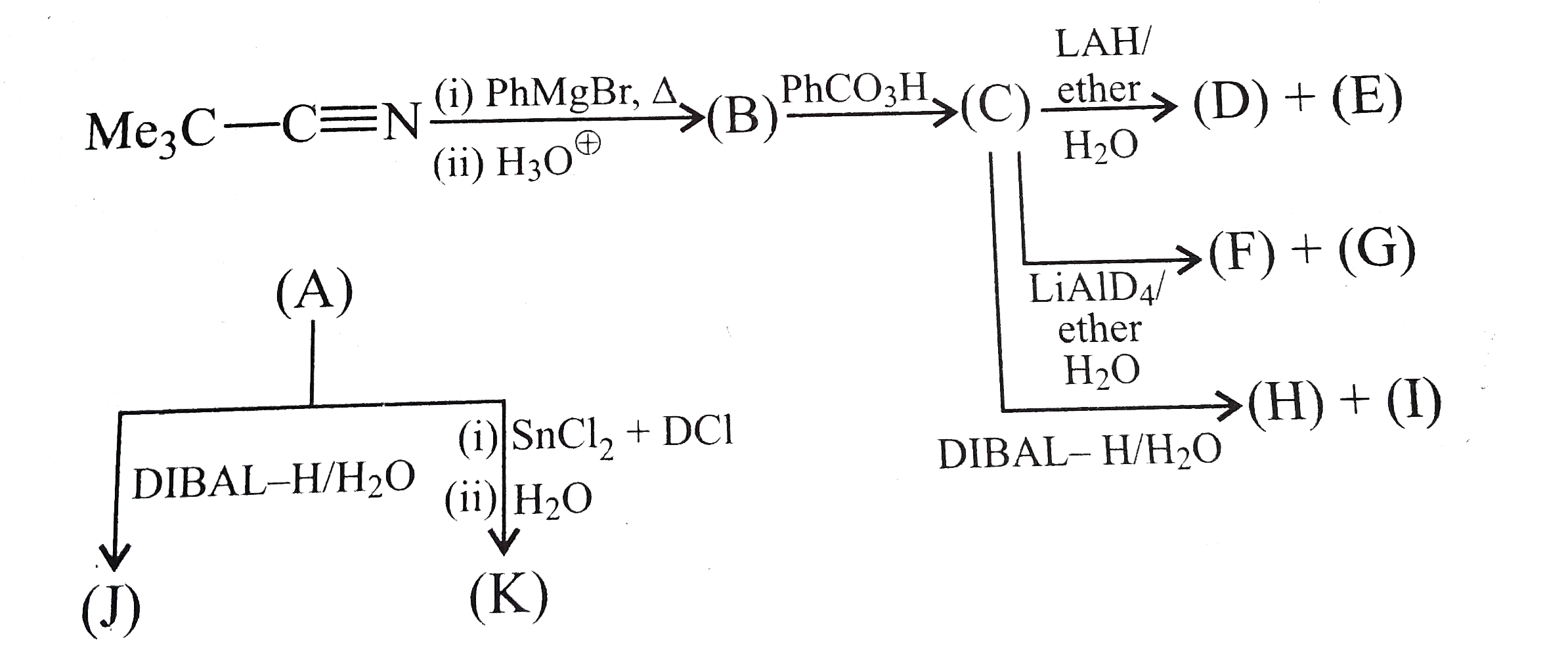The three compounds (A),(B),and (C) on hydrogenation with H2+Pd give (D),(E) and (F), respectively.

Compounds (D),(E) and (F) are :




The correct Answer is:d
Same explanation as in Solution.
Topper's Solved these Questions
- ALKENES AND ALKADIENESBOOK - CENGAGE CHEMISTRYCHAPTER - ALKENES AND ALKADIENESEXERCISE - Archives(ASSERTION-REASIOING)
4 Videos
- ALKENES AND ALKADIENESBOOK - CENGAGE CHEMISTRYCHAPTER - ALKENES AND ALKADIENESEXERCISE - Fill in the Blanks
3 Videos
- ALKENES AND ALKADIENESBOOK - CENGAGE CHEMISTRYCHAPTER - ALKENES AND ALKADIENESEXERCISE - Multiple Correct Answer Type
41 Videos
- ALKANES AND CYCLOALKANESBOOK - CENGAGE CHEMISTRYCHAPTER - ALKANES AND CYCLOALKANESEXERCISE - Archives
13 Videos
- ALKYNESBOOK - CENGAGE CHEMISTRYCHAPTER - ALKYNESEXERCISE - Exercises (Archives - Analytical and Desriptive Type)
4 Videos
Similar Questions
Hydrogenation of the compound using D2/Pd gives :

View SolutionAn organic compound (A) C4H9Cl on reacting with aqueous KOH gives (B) and on reaction with alcoholic KOH gives (C ), which is also formed on passing the vapours of (B) over the heated copper. The compound (C ) readily decolourises bromine water. Ozonolysis of (C ) gives two compounds (D) and (E ). Compound (D) reacts with NH2OH to give (F) and compound (E ) reacts with NaOH to have an alcohol (G) and sodium salt (H) of an acid. (D) can also be prepared form propyne on treatment with water in the presence of Hg2+ and H2SO4. Identify (A) to (H) with proper reasoning.
View Solution
Knowledge Check

The compounds (D) and (E) respectively are:Aa.PhOH+Me3C−CH2OHBb.PhCH2OH+Me3C−OHCc.PhOH+Me3C−CHODd.PhCHO+Me3C−OHAn inorganic red coloured compound (A) on heating gives a compound (B) and a gas (C). (A) on treatment with dil. HNO3 gives compound (D), brown colour substnace (E) and a neutral oxide (F). Compound (D) on warming gives off again gas (C). Then, (E) will be
AMn3O4BPbO2CPb3O4DFe2O3An organic compound (A) reacts with H2 to give (B) and ( C) successively. On ozonolysis of (A) , two aldehydes (D) C2H4O and ( E) C2H2O2 and On ozonolysis of (B) only propanal is formed. Compound (A), (D) & ( E) are
A B
B C
C DCH3CHO
DCH3CHO
Compound (A) (C8H8O) on treatment with NH2OH.HCI gives (B) and (C) rearrange to give (D) and (E), respectively, on treatment with acid. (B), (C),(D)and (E) are all isomers of molecular formula (C8H9NO) . When (D) is boiled with alcoholic KOH, an oil (F) (C6H7N) separates out. (F) reacts with CH3COCI to give back (D). On the other hand. (E) on boiling with alkali followed by acidification gives a white solid (G) (C7H6O2). Identify (A)to (G).
View SolutionCompound (A) (C8H8O) on treatment with NH2OH.HCl gives (B) and (C ). (B) and (C ) rearrange to give (D) and E, respectively, on treatment with acid. (B), (C ), (D), and (E ) are all isomers of molecular formula (C8H9NO). When (D) is boiled with alcoholic KOH, an oil (F) (C6H7N) separates out. (F) reacts rapidly with CH3COCl to give back (D). On the other hand, (E ) on boiling with alkali followed by acidification gives a white solid (G) (C7H6O2). Identify (A) to (G).
View SolutionAn organic compound (A) (C6H10O) on reaction with CH3MgBr followed by acid treatment gives compound (B). The compound (B) on ozonolysis gives compound (C ), which in the presence of a base gives 1-acetyl cyclopentane (D). The compound (B) on reaction with HBr gives compound (E ). Write the structures of (A), (B), (C ), (D), and (E ). Show how (D) is formed from (C ).
View SolutionA compound (A) C5H9Br on treatment with Mg in dry ether gives a compound (B) which on reaction with acetaldehyde gives an alcohol (C), on mild acidification prolonged treatment of alcohol with equivalent amount of HBr gives a compound (D) which on reaction with alcoholic KOH gives compound (E). compound (E) on ozonolysis followed by treatment with H2∅Zn gives (F). the compound (F) on treatment with base gives 1 acetyl cyclopentene (G). identify (A) to (G).
View SolutionAn organic acid (A) reacts with concentrated H2SO4 to give a neutral oxide (B), acidic oxide (c) and a diatomic oxide (D). When (D) reacts with chlorine gas, a poisonous gas (E) is evolved. This gasw with ammonia gives an organic compound (F). The compound (A) and (F) are.
View Solution
